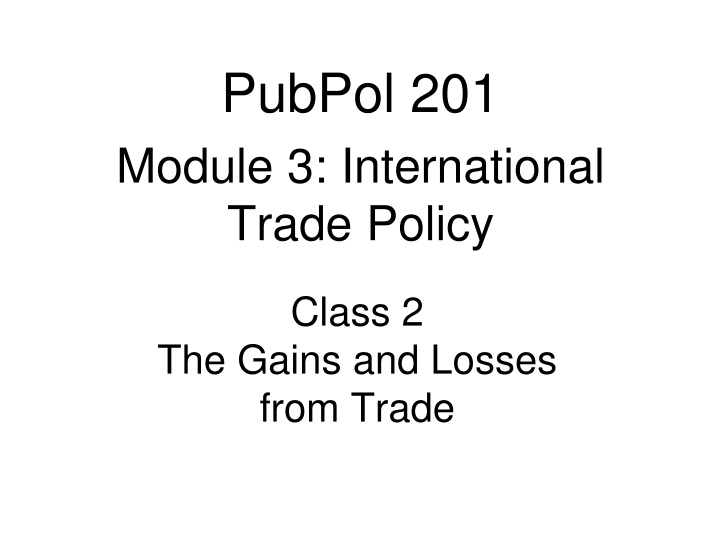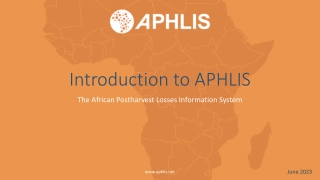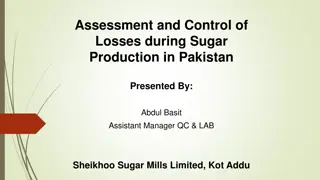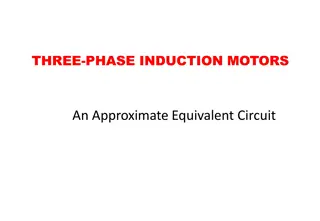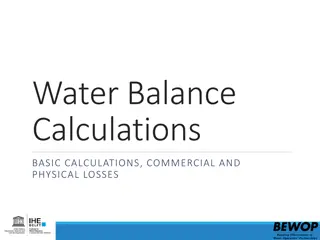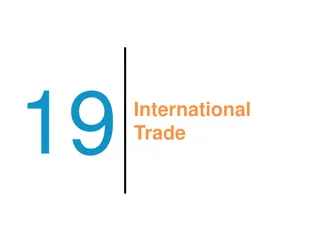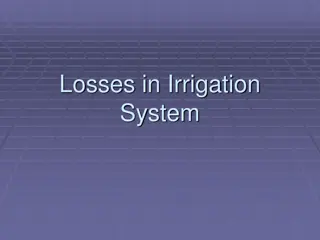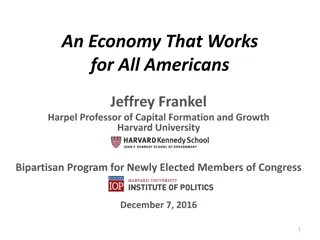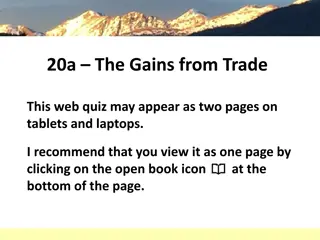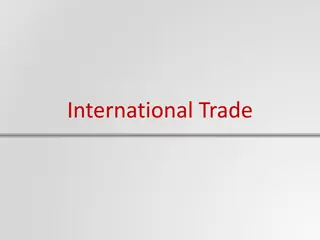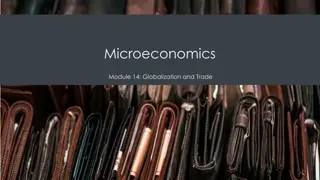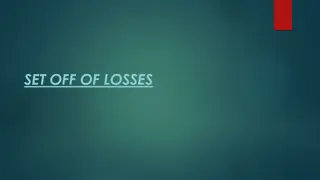International Trade Policy: Gains and Losses from Trade
International trade policy class discussing the gains and losses from trade, including concepts like comparative advantage, benefits of trade, who gains and loses, and the case for international trade. Ricardo's theory on comparative advantage and examples are explored to highlight the benefits of trade.
Download Presentation

Please find below an Image/Link to download the presentation.
The content on the website is provided AS IS for your information and personal use only. It may not be sold, licensed, or shared on other websites without obtaining consent from the author.If you encounter any issues during the download, it is possible that the publisher has removed the file from their server.
You are allowed to download the files provided on this website for personal or commercial use, subject to the condition that they are used lawfully. All files are the property of their respective owners.
The content on the website is provided AS IS for your information and personal use only. It may not be sold, licensed, or shared on other websites without obtaining consent from the author.
E N D
Presentation Transcript
PubPol 201 Module 3: International Trade Policy Class 2 The Gains and Losses from Trade
Class 2 Outline The Gains and Losses from Trade Comparative advantage Other sources of gain from trade Who gains and who loses from trade In a single market In the whole economy How strong is the case for trade? Lecture 2: Gains 2
Class 2 Outline The Gains and Losses from Trade Comparative advantage Other sources of gain from trade Who gains and who loses from trade In a single market In the whole economy How strong is the case for trade? Lecture 2: Gains 3
Comparative Advantage Due to David Ricardo (1815) Others (Adam Smith) recognized that the world could gain if production shifted From those who are worse at producing to Those who are better at it. So international trade would be beneficial if, say England was better at producing cloth Portugal was better at producing wine And therefore England exported cloth to Portugal in exchange for its wine. Lecture 2: Gains 4
Comparative Advantage Ricardo realized that each country did not need an absolute advantage in something for trade to be beneficial. Even if, say, England were absolutely worse at producing both cloth and wine There would still be gains from trade if England s relative (i.e., percentage) disadvantage were greater in one good (say wine) than the other. Lecture 2: Gains 5
Comparative Advantage Ricardo s Example Hours of work necessary to produce 1000 units Country England Portugal Cloth 100 90 Wine 120 80 England needs more labor to produce both goods. So Portugal has absolute advantage in both But England needs about About 10% more labor for Cloth About 50% more for labor Wine So England has a comparative advantage in cloth Lecture 2: Gains 6
Hours of work necessary to produce 1000 units Country Comparative Advantage England 100 Portugal 90 Cloth Wine 120 80 Without trade, the countries need the following amounts of labor to produce (and consume) 1000 units each of cloth and wine England: 100 + 120 = 220 Portugal: 90 + 80 = 170 And with that labor the world as a whole has 2000 units of each good. Lecture 2: Gains 7
Hours of work necessary to produce 1000 units Country Comparative Advantage England 100 Portugal 90 Cloth Wine 120 80 Now suppose England uses all 220 to produce cloth Since each hour produces 10 units (1000/100), it would produce 2200 units of cloth (and no wine). And suppose Portugal uses all 170 units to produce wine Since each hour produces 12.5 units (1000/80), it would produce 2125 units of wine (12.5 170) (and no cloth). The world now has more of both cloth and wine than before (2200>2000; 2125>2000). Both countries would benefit if, say, each trades half its output with the other: Each will consume 1100 units of cloth and 1062.5 units of wine Lecture 2: Gains 8
Clicker Question Hours of work necessary to produce 1000 units Country England Portugal Cloth 80 90 Wine 120 80 Which country has comparative advantage in cloth? a) England b) Portugal Note that here each has an absolute advantage in a good. Lecture 2: Gains 9
Clicker Question Hours of work necessary to produce 1000 units Country England Portugal Cloth 80 90 Wine 75 80 Which country has comparative advantage in cloth? a) England b) Portugal 80/90 < 75/80, England has relative advantage in cloth Now England had absolute advantage in both. But since Lecture 2: Gains 10
Clicker Question Hours of work necessary to produce Country US Japan 1 Window 20 30 1 Car 1500 2000 Which country has comparative advantage in cars? a) US b) Japan 2000/1500 < 30/20, it has comparative advantage in cars Here Japan has absolute disadvantage in both, but since Lecture 2: Gains 11
Comparative Advantage Ricardo s Example Shows the potential to gain from trade even if Your trading partner is less productive than you in all activities, or Your trading partner is more productive than you in all activities What actually happens depends on details of the example, including All the productivities Country sizes Demands for the goods But economists have generalized this example into models that show that The world (as a whole) must gain from trade, and No country (as a whole) will lose from trade Lecture 2: Gains 12
Comparative Advantage How markets generate trade Wages reflect productivity In Ricardo s example, the wage per hour in England must be lower than in Portugal It is this that makes England s cloth cheaper than Portugal s and makes trade happen. The wage in England only has to be about 10% lower than the wage in Portugal for English cloth to be cheaper than Portuguese cloth At that wage, Portuguese wine is still cheaper than English wine Lecture 2: Gains 13
Comparative Advantage Why countries often fear trade Low-productivity developing countries fear trade with high-productivity developed countries Fear: How can we compete with the US, whose technology, capital, education, etc. make it far more productive than we are? Answer: You can compete, because your wage is lower. High-wage developed countries fear trade with low- wage developing countries Fear: How can we compete with Mexico, whose wages are so much lower than ours? Answer: Their wages are low because their productivity is low. Lecture 2: Gains 14
Clicker Question Hours of work necessary to produce Country US Japan 1 Window 20 30 1 Car 1500 2000 Which country must have the lower wage? a) US b) Japan c) Can t tell cost more. If Japan s wage were as high as the US wage, its cars would Lecture 2: Gains 15
Clicker Question Hours of work necessary to produce 1000 units Country England Portugal Cloth 80 90 Wine 120 80 Which country must have the lower wage? a) England b) Portugal c) Can t tell Lecture 2: Gains 16
Class 2 Outline The Gains and Losses from Trade Comparative advantage Other sources of gain from trade Who gains and who loses from trade In a single market In the whole economy How strong is the case for trade? Lecture 2: Gains 17
Other Gains from trade Comparative advantage is not the only reason that countries gain from trade Other sources of gain from trade Scale economies Greater competition Increased variety Increased productivity Lecture 2: Gains 18
Other Gains from trade Scale economies In many industries, costs per unit fall as output rises Examples: cars, computer software, pharmaceuticals Assembly line lowers costs but only for producing many cars Upfront cost of writing software, compared to almost zero cost of making copies of it Research cost for new drugs far larger than cost of making them Lecture 2: Gains 19
Other Gains from trade Scale economies and trade Without trade, a small country produces everything at small scale and high cost By specializing in fewer goods and exporting, cost of each goes down Lecture 2: Gains 20
Other Gains from trade Imperfect competition With few firms in an industry, firms have market power and charge prices well above cost These high prices reduce demand below what would be justified by their lower cost Society suffers lower welfare (by which we mean aggregate well-being, but mainly the benefits from consuming) Lecture 2: Gains 21
Other Gains from trade Imperfect competition and trade Without trade, a small country has few firms in each industry, which therefore use market power to charge high prices With trade, those firms must compete with imports and prices fall closer to costs Lecture 2: Gains 22
Other Gains from trade Variety Buyers benefit when more varieties are available Consumers can choose what they most want Firms buying inputs can get what works best for their particular needs Economic welfare therefore rises with increases in variety of products available Lecture 2: Gains 23
Other Gains from trade Variety and trade Without trade, a small country cannot provide many choices With trade consumers and firms have the world s varieties to choose from Lecture 2: Gains 24
Other Gains from trade Firm productivity Firms in the same industry differ in their productivity for various reasons Managerial ability Location and availability of inputs Product design More productive firms produce and sell more than less productive firms and make more profit Lecture 2: Gains 25
Other Gains from trade Firm productivity and trade When a country opens to international trade Its most productive firms can expand and export Its least productive firms compete with imports and Reduce output and sales, or Shut down Thus average productivity of the industry rises This means that the country and the world benefit from higher productivity and lower costs Lecture 2: Gains 26
Discussion Question Can you think of any down-sides to any of these? Scale economies Increasing competition Variety Expansion of more productive firms Lecture 2: Gains 27
Class 2 Outline The Gains and Losses from Trade Comparative advantage Other sources of gain from trade Who gains and who loses from trade In a single market In the whole economy How strong is the case for trade? Lecture 2: Gains 28
Who gains and loses from trade Ricardo s example already points to some losers from trade Makers of wine in England Makers of cloth in Portugal In the simple model, there is only labor, which ends up earning a higher wage in the other industry But in fact those workers must first bear the cost of moving to that other industry Lecture 2: Gains 29
Who gains and loses from trade In general, in order for there to be trade and gains from trade Some industries must expand, and Others must contract Lecture 2: Gains 30
Who gains and loses from trade Workers and owners in the contracting industries are hurt Especially if they cannot move easily to another industry We call those specific factors The dislocated workers and owners Do gain from trade as consumers But they lose much more as producers Lecture 2: Gains 31
Who gains and loses from trade Thus costs of trade include Plants, firms, and industries that shrink or close Workers become unemployed Owners lose profits Whole communities can lose if they depended on a few major employers We ll see this more in Class 4 on the China Shock Lecture 2: Gains 32
Benefits and Costs of Trade in a Single Market Economists use supply-and-demand analysis to work out the effects of policies Taxes Subsidies Regulations Etc. This includes the use of tariffs to reduce trade and tariff reductions to increase trade. We ll just look at moving from no trade to free trade. Lecture 2: Gains 33
Benefits and Costs of Trade in a Single Market Consider an economy that produces and consumes a good Without trade, the domestic price PD equates supply and demand Lecture 2: Gains 34
Without Trade P S PD D Q Lecture 2: Gains 35
Supply Curve, S Quantities, Q, that producers want to sell at different prices, P. At higher prices, they supply more Without Trade P S PD D Q Lecture 2: Gains 36
Without Trade P S PD Demand Curve D Quantities, Q, that consumers want to buy at different prices, P. At higher prices, they demand less D Q Lecture 2: Gains 37
Without Trade P S Equilibrium domestic price, PD Price at which quantity supplied equals quantity demanded. PD D Q Lecture 2: Gains 38
Benefits and Costs of Trade in a Single Market Consider an economy that produces and consumes a good Without trade, price PD equates supply and demand With trade, facing a world price PW, its domestic price becomes PW and it either exports or imports the good Exports if PW > PD Imports if PW < PD Lecture 2: Gains 39
Export P X S PW PD D Q Lecture 2: Gains 40
Benefits and Costs of Trade in a Single Market Who gains and who loses from trade in a market that exports? Since price goes up Sellers gain Buyers lose Sellers gain more than buyers lose, by the amount shown as the shaded triangle (Don t worry about understanding why, unless you ve taken Econ 101) Lecture 2: Gains 41
Import P S PD PW M D Q Lecture 2: Gains 42
Benefits and Costs of Trade in a Single Market Who gains and who loses from trade in a market that imports? Since price goes down Sellers lose Buyers gain Buyers gain more than sellers lose, by the amount shown as the shaded triangle (Again don t worry about why) Lecture 2: Gains 43
Benefits and Costs of Trade in a Single Market Note that in both cases Suppliers include not just the owners of the firms, but also Workers in the industry who may change employment and/or wages Suppliers of raw materials and intermediate inputs to the industry, including their owners and workers Demanders may include not just consumers, but also Firms that use the product as an input And their owners and workers Lecture 2: Gains 44
Benefits and Costs of Trade in a Single Market Summary Effects of opening a single market Benefits Costs >> Suppliers (firms & workers) Demanders (firms & workers) Benefits are greater than costs Demanders (firms & workers) Suppliers (firms & workers) If PW > PD then export If PW < PD then import Either way Lecture 2: Gains 45
Clicker Question NAFTA reduced Mexico s tariffs on imported corn (maize). Who lost from this? a) US farmers and Mexican farmers b) US farmers and Mexican consumers c) US consumers and Mexican farmers d) US consumers and Mexican consumers Because trade caused the price of corn to rise in the US and fall in Mexico. Lecture 2: Gains 46
Clicker Question NAFTA reduced Mexico s tariffs on imported corn (maize). Who gained from this? a) US farmers and Mexican farmers b) US farmers and Mexican consumers c) US consumers and Mexican farmers d) US consumers and Mexican consumers Lecture 2: Gains 47
Class 2 Outline The Gains and Losses from Trade Comparative advantage Other sources of gain from trade Who gains and who loses from trade In a single market In the whole economy How strong is the case for trade? Lecture 2: Gains 48
Who gains and loses from trade Given enough time, many displaced workers will find other jobs. But they may not pay as well. (Same for owners.) Even workers in expanding industries may suffer lower wages due to competition with workers released from elsewhere. In general, trade affects wages of different types of labor and prices of other factors. Lecture 2: Gains 49
Who gains and loses from trade A fundamental Theorem of international trade theory says that Abundant factors gain from trade Scarce factors lose from trade (The theorem is called the Stolper-Samuelson Theorem, named for two economists whose paper was published in 1941. Stolper later spent much of his career here at Michigan.) Lecture 2: Gains 50
